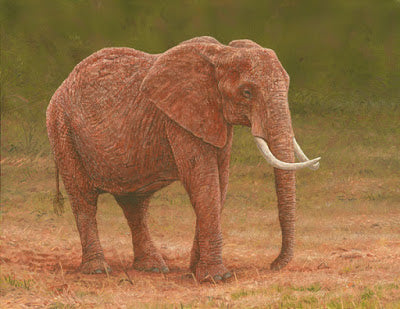A report published by World Wildlife Fund last month claimed that 52% of the world's animals have vanished. It followed research earlier in the year that claimed the
cumulative effects of climate change, pollution and deforestation has meant vertebrates are disappearing at a rate 114 times faster than normal. Apparently, since 1900 more than 400 more vertebrates have
disappeared. Such a loss would normally be seen over a period of up to 10,000
years. Thankfully, the authors of this new report believe it is still
possible to avoid a "dramatic decay of biodiversity" through
intensive conservation. But we need to act fast to save what we can. Already,
according to one of the scientists, Stanford University
professor Paul Ehrlich, "There are examples of species all over the world
that are essentially the walking dead.”
 |
| Elephant Oil painting by Robert E Fuller |
I found that statement really chilling. Conservation is at the heart of what I do - after all I owe my livelihood to the animals that I paint. Last year I worked alongside conservationists in The
Galapagos Islands helping to preserve unique species in the remote Ecuadorian
archipelago. I also donate a percentage of the sales of my paintings of tigers to a conservation group protecting tigers in India and also support Save the Albatross.
| Tiger of Kanha, l imited edition print by Robert E Fuller |
Closer to home, I am the founder of a conservation group to
protect barn owls on the Yorkshire Wolds, putting up nest boxes on farmland throughout
the area, monitoring local populations and even putting out supplementary food for owls during tough times. Although barn owls are not endangered, they struggle to survive on the Yorkshire Wolds where the winters can be harsh. Prolonged snowfall or a lack of voles, their main diet, can have devastating effects on owl populations.
I also work with Jean Thorpe of Ryedale Wildlife Rehabilitation to restore owls, hedgehogs, and any other creature that is handed in to me by customers or friends, to the wild. This summer a scheme I devised to persuade wild owls to adopt injured or abandoned owlets has proved so successful I have been sharing my experiences with the World Owl Trust, of which I am a patron. To read about how I did this and to watch a short video of how the wild owls took to the chicks click here.
Sometimes my efforts to save the creatures I love get me into difficulties - like the time I stumbled across a gang baiting badgers with dogs. I was so upset by their cruelty I called the police and photographed them in the act, which led to my becoming the main witness in a criminal prosecution. The gang were eventually sent to prison. You can read more on this grim story by clicking here.
But helping wildlife doesn't need to be so dramatic. In fact, it's the small things that make the most difference. My garden in Thixendale, North Yorkshire, is planted specifically for wildlife, for instance.
Since I moved here in 1998 I have planted a woodland and wildflower meadow, dug a pond and filled the borders with shrubs and bushes to attract everything from sparrows to weasels and stoats. Since I've been here my tree sparrow population has burgeoned from just one pair to 30!
Tree sparrows are disappearing at an alarming rate, with 93% reduction since the 1970s. I found that just by slowly improving the habitat in my own garden I have been able to make a huge difference for them. Within the first year of planting out my garden my population had tripled and so I built special nest boxes adapted for them.
Now by then end of each summer there are 250-300 sparrows flocking around the garden. By early winter most of these birds disperse to other farms where they have now formed new colonies. I love tree sparrows, they are such characters. I love hearing their deafening chatter in the hedgerows as they squabble. The only problem is my bird food bill. They easily consumer 20kgs a week!
But when it comes to conservation you can never do enough and I'm forever working against the clock to help the creatures living near me as well as the exotic animals I come across on my travels.
My latest plan is to devote an exhibition of my paintings to raise awareness for endangered species. The event, which I have called Saving Nature: Near & Far, runs from November 7-29th here at my gallery in Thixendale.
 |
| Squirrel of Formby, limited edition print by Robert E Fuller |
I will be exhibiting paintings of the animals that need help alongside information boards and videos proffering
information on what visitors can do. There is so much that ordinary people can do to conserve wildlife on
their own doorsteps.
Sometimes it’s just small things like putting
up a nest box or leaving grass verges uncut for barn owls to hunt in. I think sometimes conservation can feel a little
overwhelming, but if everybody does one small thing then we can achieve quite a
lot.
I've compiled a list of UK species that could be extinct by the end of
the century. Click here to see my list and find out what you can do to help. I've posted a painting next to each which I hope will inspire you to act.
















